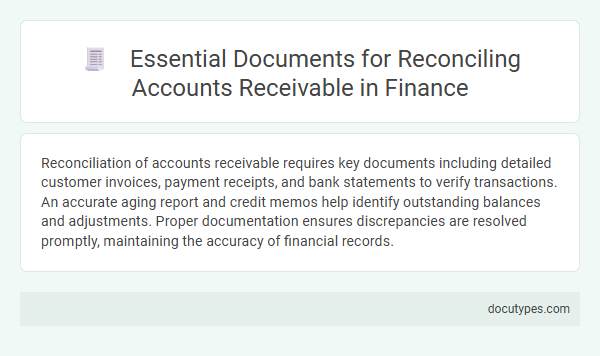Reconciliation of accounts receivable requires key documents including detailed customer invoices, payment receipts, and bank statements to verify transactions. An accurate aging report and credit memos help identify outstanding balances and adjustments. Proper documentation ensures discrepancies are resolved promptly, maintaining the accuracy of financial records.
Introduction to Accounts Receivable Reconciliation
| Introduction to Accounts Receivable Reconciliation | |
|---|---|
| Definition | Accounts Receivable Reconciliation is the process of verifying and matching the amounts recorded in the accounts receivable ledger with the amounts recorded in the general ledger to ensure accuracy and completeness of financial records. |
| Purpose | To identify discrepancies, errors, or omissions in receivable accounts, ensuring the company's financial statements accurately reflect outstanding customer balances. |
| Key Documents Required for Reconciling Accounts Receivable | |
| Accounts Receivable Ledger | Detailed listing of individual customer account balances, including invoice dates, amounts, and payments applied. |
| Customer Invoices | Official billing documents provided to customers that detail the products or services sold, quantities, prices, and due dates for payment. |
| Payment Receipts and Bank Statements | Records showing payments received from customers, including dates and amounts, which are compared against invoices for accuracy. |
| Credit Memos | Documents issued to customers to reduce the amount receivable, usually due to returns, discounts, or billing adjustments. |
| General Ledger | Master record containing summarized financial transactions and the total accounts receivable balance used to confirm ledger accuracy. |
| Customer Statements | Periodic summaries sent to customers listing outstanding invoices and payments, serving as a verification tool during reconciliation. |
Importance of Proper Documentation in AR
Proper documentation is crucial for reconciling accounts receivable accurately. It ensures that all transactions are recorded correctly and discrepancies are identified promptly.
Key documents include invoices, payment receipts, credit memos, and customer statements. Maintaining organized records helps prevent errors and supports audit compliance. Your ability to reconcile accounts receivable depends on having these essential documents readily available.
Invoice Records and Supporting Documents
Reconciling accounts receivable requires detailed documentation to ensure accuracy and prevent discrepancies. Key documents include invoice records and supporting documents that verify transactions.
- Invoice Records - These provide the primary details of sales transactions, including invoice numbers, dates, customer information, and amounts owed.
- Payment Receipts - Receipts confirm payments received from customers, matching payments to specific invoices for accuracy in reconciliation.
- Credit Memos - These documents account for any adjustments, returns, or discounts that affect the total receivable balance.
Your ability to reconcile accounts accurately depends on having organized and complete documentation for every transaction involved.
Payment Receipts and Bank Statements
Reconciling accounts receivable requires accurate payment receipts that confirm customer payments. These receipts serve as proof of funds received and help ensure transaction accuracy.
Bank statements are essential documents that provide an overview of all deposits and withdrawals. Comparing these statements with payment receipts helps identify discrepancies and maintain accurate financial records.
Customer Statements and Account Confirmations
Reconciliation of accounts receivable requires specific documentation to verify outstanding balances and payments accurately. Customer statements and account confirmations are essential documents that facilitate this process.
- Customer Statements - Detailed reports sent to customers showing all invoices, payments, and outstanding balances for a specific period.
- Account Confirmations - Formal acknowledgments from customers confirming the accuracy of the receivable balances.
- Invoice Copies - Supporting documents that provide proof of the billed amounts and terms of sale.
Credit Memos and Adjustment Documents
Reconciling accounts receivable requires precise documentation to ensure accuracy in financial records. Key documents include credit memos and adjustment documents, which reflect changes to outstanding customer balances.
Credit memos serve as official records for returns or discounts, reducing the amount owed by customers. Adjustment documents address discrepancies such as billing errors or payment corrections, aiding in accurate account reconciliation for your finance team.
Aging Reports and Unpaid Invoice Lists
Reconciling accounts receivable requires accurate and detailed documentation to ensure all outstanding amounts are correctly accounted for. Key documents include aging reports and unpaid invoice lists, which provide essential insights into the status of receivables.
- Aging Reports - Categorize receivables by the length of time invoices have been outstanding to identify overdue accounts.
- Unpaid Invoice Lists - Provide a detailed record of all invoices that remain unpaid, supporting the identification of discrepancies.
- Supporting Payment Records - Verify received payments against invoices to confirm accurate account balances.
Internal Reconciliation Worksheets
What documents are essential for reconciling accounts receivable using internal reconciliation worksheets? Internal reconciliation worksheets require detailed invoices and payment records to cross-check customer balances. These documents help ensure accuracy by verifying that recorded payments match outstanding invoices.
Audit Trails and Reconciliation Logs
Reconciling accounts receivable requires detailed audit trails that provide a chronological record of all transactions, ensuring transparency and accuracy. Reconciliation logs are essential documents that track adjustments and discrepancies, facilitating effective error identification and resolution. You must maintain these documents to support the integrity of your financial statements and streamline the audit process.
What Documents Are Required for Reconciling Accounts Receivable? Infographic

